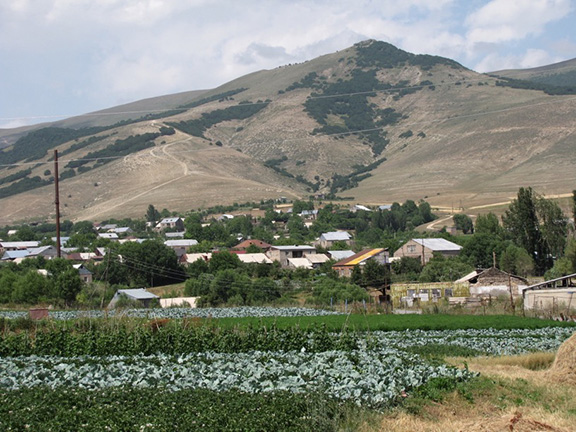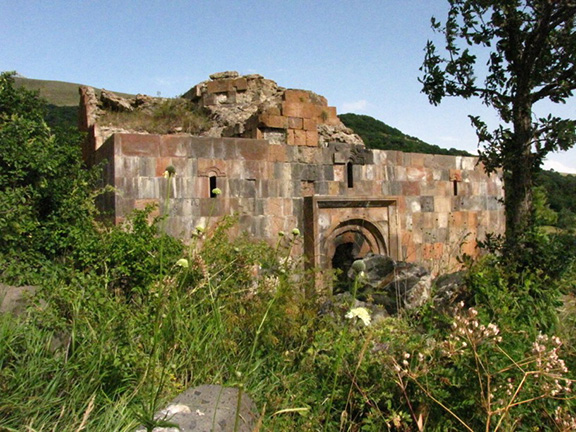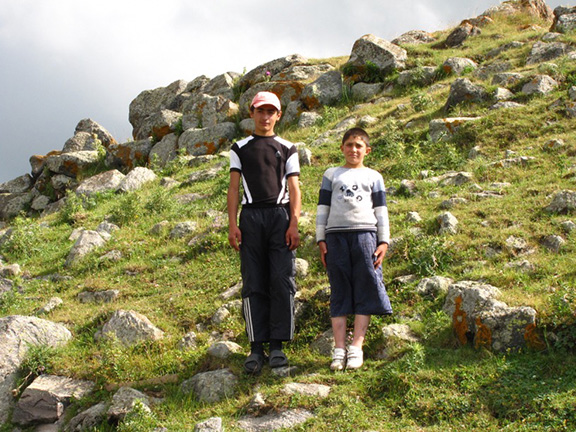BY HOVSEP DAGDIGIAN
After deciding to turn back from my hike up a wooded dirt road to the Teghenyats Monastery in the village of Bujhakan, we asked some villagers if someone with a WAZ (a Russian jeep-like vehicle) would be willing to take us to the monastery. We, of course, would pay for fuel expenses. A couple of cell phone calls later a driver with what resembled a WWII US Jeep showed up. After a 20-minute very rough drive we arrived at the monastery. The monastery, on a hill surrounded by trees, dates from the 6-7th C and operated through the 12th C. On site are remains of various structures including remnants of the church, a bakery, a dining hall, and a large number of intricately carved stones. Our driver indicated that there are other monasteries nearby. But, he added, the most practical way to get to them is on horseback.
Back in the village of Bujhakan, with fields of bright green cabbage, I asked if there were any historic sites within the village. “Just remnants of an old church” was the dismissive reply. “I like old churches.” “But there’s just one wall standing and one khachkar”, to which I answered, “I like walls, and old khachkars.” The dirt road through the village, though flat, was too rutted for our car, so I walked. Showing me the way was a 14-year-old young man, Abas. Abas spoke beautiful Armenian with no English or Russian words mixed in, which is not what one usually hears in Yerevan. We talked of many things during our 20-minute walk to the church. Abas explained how each year some of the crops thrive, while others do not. This was a great year for cabbage. He explained how one could tell of impending weather by viewing the clouds over the mountains, and paying attention to the birds. He was very familiar with the surrounding mountains, often taking animals up there to graze. He also expressed the importance of history, his village’s history, and of Armenian traditions. When I asked him, given his interest in Armenian history, if he had seen much of Armenia, he replied that he had not. But, he added, he and his school class would shortly be visiting the Garni Temple and Geghart. He was quite excited about this. When we got back to our car he disappeared – I did not get a chance to thank this inspiring young man.
Some time after we were in the village of Hnaberd (which translates to “old fort”). I had read of remnants of a Urartian fortress on the top of one of the foothills nearby – between the village and the slopes of Mt. Aragats. When asking a number of villagers how to get there, they would point to one of the hilltops in the distance and explain in rather vague terms the best way to get there. Finally someone volunteered to find a couple of boys to take me there. Two boys, good friends, Antranig and Hampartsoum, volunteered to lead the way. They were 12 and 14 years old. Again, their Armenian was beautiful, devoid of foreign words or slang. As we began, it was obvious that they were ready to sprint up the hill. These hills are their back yard and their playground. They are accustomed to traipsing all over this beautiful landscape. Of course they slowed down for me! Their consideration for my welfare was constant, always asking if they could carry my water bottle or cameras, or if I was ok.
Half way up the hill I heard a loud roar. About half way between the village and us a jet from the nearby Russian base near the Turkish border was practicing maneuvers in the valley below. By the time I readied my camera it was gone. I waited another 5 minutes or so for an opportunity to get a truly unique photograph, but the pilot was already maneuvering in another valley.
At the top of the hill were concentric walls of what archeologists call a cyclopean fort; crude undressed stones arranged for defense. The fort was interesting though not spectacular. But the view was great and my two guides were wonderful.
Heading back down, the older boy indicated that the first house we passed was his, and he introduced me to his father who was cutting hay or wheat with a scythe. I got the impression that his father, though not a large man and despite the heat, could continue this strenuous work for days upon end. The boy’s mother invited me to stay for supper, but that was impossible. I had to meet my wife elsewhere in the village and we were already late to meet friends in Gyumri. But the boy’s parents insisted, and of course they wanted to know who this stranger was who spent the last couple of hours with their son. I politely declined dinner but indicated a cup of coffee would be great.
Sitting at the table with the boy’s father, he lamented the fact that so many people are leaving Armenia. “What will become of our country?” he asked. Despite all the other hardships, economic and otherwise, this was his primary worry. The government doesn’t even know we exist, other organizations don’t know we’re here either, we are forgotten”, he said. Unfortunately I’ve heard this too many times. I replied, “I have friends, and though they have not met you personally, they know that you and people like you exist, and they have not forgotten.” I added that I can’t speak for the government or any other organization, but “I shall not forget you.” We talked a bit more, then I excused myself – I had to get going. Our talk lasted 5 minutes, 10 at the most. We got up to walk out of the house together. I said “I don’t know if we’ll ever meet again; we probably won’t.” But, I added, “Be assured that I will not forget.” We looked each other in the eyes. I’d known him for 5-10 minutes, we understood each other perfectly; we exactly were on the same wavelength. He approached me and we hugged each other, with tears in our eyes. We said goodbye. I walked away with a complex mix of emotions: upset that these wonderful people are forgotten, sad that I had to leave, and frustrated that I was unable to be of much help. This was not the first time this had happened. I think of these people constantly – hoping they are well, hoping that their children can achieve their ambitions and realize their full potential without having to leave Armenia.
Source: Asbarez
Link: Unseen Armenia: My Young Hiking Guides – Unforgotten




